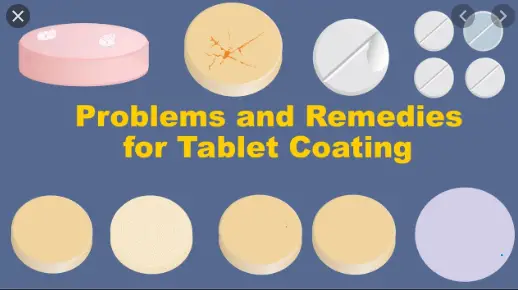PROBLEMS AND REMEDIES FOR TABLET COATING
Blistering
It is local detachment of film from the substrate forming blister.
Reason: Entrapment of gases in or underneath the film due to overheating either during spraying or at the end of the coating run.
Cause and Remedy of Blistering:
Cause: Effect of temperature on the strength, elasticity and adhesion of the film.
Remedy: Use mild drying condition.
Cratering
It is defect of film coating whereby volcanic-like craters appears exposing the tablet surface.
Reason: The coating solution penetrates the surface of the tablet, often at the crown where the surface is more porous, causing localized disintegration of the core and disruption of the coating.
Causes and Remedies of Cratering:
Causes:
• Inefficient drying.
• Higher rate of application of coating solution.
Remedies:
• Use efficient and optimum drying conditions.
• Increase viscosity of coating solution to decrease spray application rate.
Picking
It is defect where isolated areas of film are pulled away from the surface when the tablet sticks together and then part.
Reason: Conditions similar to cratering that produces an overly wet tablet bed where adjacent tablets can stick together and then break apart.
Causes and Remedies of Picking:
Causes:
• Inefficient drying.
• Higher rate of application of coating solution.
Remedies:
• Use optimum and efficient drying conditions or increase the inlet air temperature.
• Decrease the rater of application of coating solution by increasing viscosity of coating solution.
Pitting
It is defect whereby pits occur in the surface of a tablet core without any visible disruption of the film coating.
Reason: Temperature of the tablet core is greater than the melting point of the materials used in the tablet formulation.
Cause and Remedy of Pitting:
Cause: Inappropriate drying (inlet air) temperature.
Remedy: Dispensing with preheating procedures at the initiation of coating and modifying the drying (inlet air) temperature such that the temperature of the tablet core is not greater than the melting point of the batch of additives used.
Blooming
It is defect where coating becomes dull immediately or after prolonged storage at high temperatures.
Reason: It is due to collection on the surface of low molecular weight ingredients included in the coating formulation. In most circumstances the ingredient will be plasticizer.
Cause and Remedy of Blooming:
Cause: High concentration and low molecular weight of plasticizer.
Remedy: Decrease plasticizer concentration and increase molecular weight of plasticizer.
Blushing
It is defect best described as whitish specks or haziness in the film.
Reason: It is thought to be due to precipitated polymer exacerbated by the use of high coating temperature at or above the thermal gelation temperature of the polymers.
Causes and Remedies of Blushing:
Causes:
• High coating temperature.
• Use of sorbitol in formulation which causes largest fall in the thermal gelation temperature of the Hydroxy Propyl Cellulose, Hydroxy Propyl Methyl Cellulose,Methyl Cellulose and Cellulose ethers.
Remedies:
• Decrease the drying air temperature.
• Avoid use of sorbitol with Hydroxy Propyl Cellulose, Hydroxy Propyl Methyl Cellulose, Methyl Cellulose and Cellulose ethers.
Colour Variation
It is a defect which involves variation in colour of the film.
Reason: Alteration of the frequency and duration of appearance of tablets in the spray zone or the size/shape of the spray zone.
Cause and Remedy of Colour Variation:
Cause: Improper mixing, uneven spray pattern, insufficient coating, migration of soluble dyes-plasticizers and other additives during drying.
Remedy: Go for geometric mixing, reformulation with different plasticizers and additives or use mild drying conditions.
Infilling
It is defect that renders the intagliations indistinctness.
Reason: Inability of foam, formed by air spraying of a polymer solution, to break. The foam droplets on the surface of the tablet breakdown readily due to attrition but the intagliations form a protected area allowing the foam to accumulate and set. Once the foam has accumulated to a level approaching the outer contour of the tablet surface, normal attrition can occur allowing the structure to be covered with a continuous film.
Cause and Remedy of Infilling:
Cause: Bubble or foam formation because of air spraying of a polymer solution.
Remedy: Add alcohol or use spray nozzle capable of finer atomization.
Orange Peel/Roughness
It is surface defect resulting in the film being rough and non-glossy. Appearance is similar to that of an orange.
Reason: Inadequate spreading of the coating solution before drying.
Causes and Remedies of Orange Peel/Roughness:
Causes:
• Rapid Drying.
• High solution viscosity
Remedies:
• Use mild drying conditions.
• Use additional solvents to decrease viscosity of solution.
Cracking/Splitting
It is defect in which the film either cracks across the crown of the tablet (cracking) or splits around the edges of the tablet (Splitting).
Reason: Internal stress in the film exceeds tensile strength of the film.
Cause of Cracking/Splitting:
• Use of higher molecular weight polymers or polymeric blends.
• Use lower molecular weight polymers or polymeric blends. Also adjust plasticizer type and concentration.
Bridging
This occurs when the coating fills in the lettering or logo on the tablet and is typically caused by improper application of the solution, poor design of the tablet embossing, high coating viscosity, high percentage of solids in the solution, or improper atomization pressure. During drying, the film may shrink and pull away from the sharp corners of an
intagliation or bisect, resulting in a bridging of the surface. This defect can be so severe that the monogram or bisect is completely obscured.
Remedy: Increasing the plasticizer content or changing the plasticizer can decrease the incidence of bridging.

